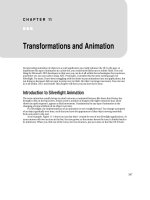kiddy lit1 sans animation
Bạn đang xem bản rút gọn của tài liệu. Xem và tải ngay bản đầy đủ của tài liệu tại đây (1.76 MB, 37 trang )
History of Children’s
Literature
Children’s literature is a relatively
new kind of literature.
• Before 1850, books
taught lessons on
manners and morals.
•Books also contained
lessons on the ideas of
history and science that
existed at the time.
Children’s Books
• Children found the books dull,
so they read stories intended
for adults.
– Robinson Crusoe by Daniel Defoe
– Gulliver’s Travels by Jonathan
Swift
– Rip Van Winkle by Washington
Irving
Advantages in reading
adult books:
• Made it possible for
children to live more lives
than one.
• Able to find new friends,
laughter, knowledge, and
an understanding of people
of all ages in all parts of
the world.
Early Beginnings
• In 600 A.D., the
Old English period,
monks and other
learned men wrote
“lesson books” for
children.
Early Beginnings
• Aldhelm (640?-700AD), Bishop of Sherborne,
was probably the first man to write lesson
books for children.
– Riddles and puzzles children had to solve were
written in Latin.
– He set the pattern for all books of instruction
from that time up to 1500 AD.
– All books used question and answer form
and were written in verse.
Early Beginnings
• The Venerable Bede (763-735AD)
was a teacher at a monastery school.
– His lessons showed more imagination.
– They were a spark of learning in the
Dark Ages.
– They contained all the knowledge then
known of natural science, natural
history, and the study of plants and
flowers and stars.
Early Beginnings
• Egbert of York (766 AD) founded the
famous school of York.
– Collected the works of the previous monks and
books by outstanding Greek and Roman
authors.
– Wrote a variety of lesson
books, still using question
answer (dialogue)
method.
and
Early Beginnings
• Egbert of York (766 AD)
[continued]
– Wrote many books on grammar.
– Tutored sons and daughters of the
household at the court of Charlemagne (the
first Holy Roman Emperor).
– This is also one of the earliest records of
co-education.
Early Beginnings
• Alfred the Great (849-399
AD), King of England drove
back the invasion of the
Danes.
– He translated Latin literature
into Anglo-Saxon with the
help of many scholars.
Anglo-Saxon
• Anglo-Saxon Name given to distinguish
the barbarian settlers of Britain, "the
English Saxons," from their kindred still
on the continent.
• Now generally used to define the period
in England between the collapse of
Roman power c. 410 and the Norman
Conquest of 1066, and applied to
artifacts - Anglo-Saxon pottery,
metalwork, houses, etc.
Early Beginnings
• Alfred the Great
[continued]
– Until 1350, children in
monastery schools had to
read and speak Latin in and
out of school.
– He had the best literature
of his time translated from
Latin into old English so it
would be understandable to
the common man.
Early Beginnings
• Anselm (1033-1109
AD), the Archbishop of
Canterbury, wrote the
first encyclopedia for
children.
The Middle English Period
• In 1066 William the
Conqueror and his Norman
French knights invaded and
won England.
• They were the Anglo-Saxons,
who gave England its name
(Angel Land).
The Middle English Period
• French words were
introduced into English
because it was the language
of the nobility.
–
–
–
–
mouton
carpentier
fourniture
tailleur
The Middle English Period
• Children of nobility
continued to receive
instruction in manners and
morals of the period.
• This period lasted until
the invention of the
printing press by
Gutenberg in 1456 in
Germany and the coming
of the Renaissance.
The Middle English Period
• Renaissance comes from the French
words
– “re,” meaning “again” and
– “naitre,” meaning “born.”
– Hence, a “rebirth.”
• The first book published was The
Bible.
The Middle English Period
• William Caxton was the
creator of the first
English printer in 1476.
• His first publication was
Aesop’s Fables.
The Renaissance
• Books were too
expensive to be used by
children, so the
Hornbook was created
for them about 1550.
• It was the first
“permanent” book.
The Hornbook
• It was a square piece of
wood with a handle at
one end which measured
2¾ inches by 5 inches.
• A printed page of vellum
(made from skin of calf,
lamb, or goat) was
pasted on the board.
The Hornbook
• The page was protected by a
transparent piece of horn (a hard,
smooth material forming the outer
cover of the horns of cattle and other
related animals).
• The book was often bound by a metal
rim, had a cord through a hole in the
handle, and was fastened to a child’s
belt.
• Another source said it was worn about
the neck.
The Hornbook
• The text contained
the Crusaders’
cross, followed by
the alphabet in
lower and upper
case.
• Groups of syllables
were written below
the letters.
The Hornbook
• The final text was “The
Lord’s Prayer.”
• The next piece of text
was the words “In the
name of the Father and
of the Son and of the
Holy Ghost. Amen.”
The Renaissance
• After the hornbook,
rhymed alphabets and
primers were published
for children.
– The Royal Primer had a
letter of alphabet, followed
by a familiar verse.
– A In Adam’s fall, we sinned
all.
The Renaissance
• This primer sold 5 million
copies during the hundred
years it was used as a text
book for younger children.
• The Royal Primer was followed
by the New England Primer,
published in Boston in 1690.
• [Remember, the pilgrims arrived in 1620.]









